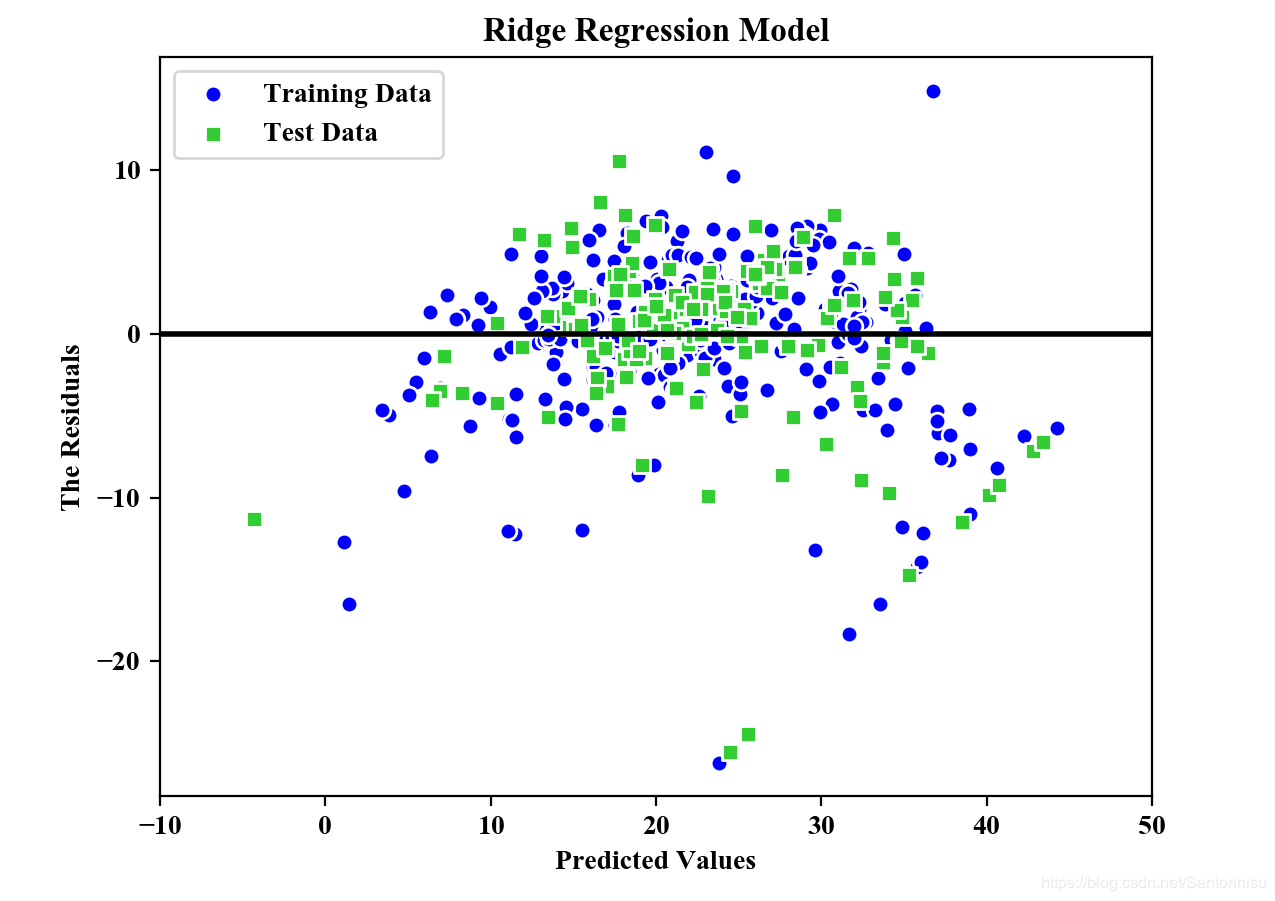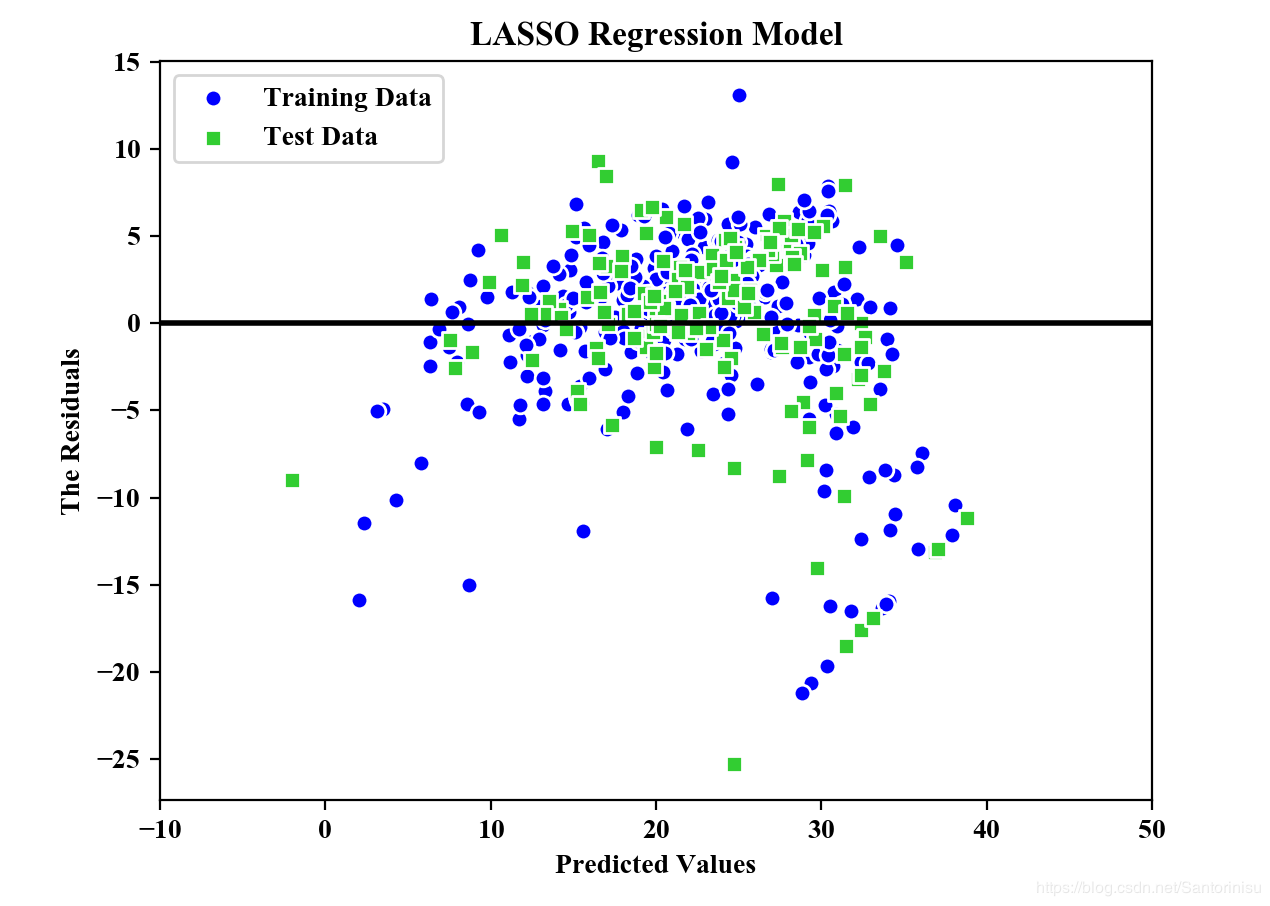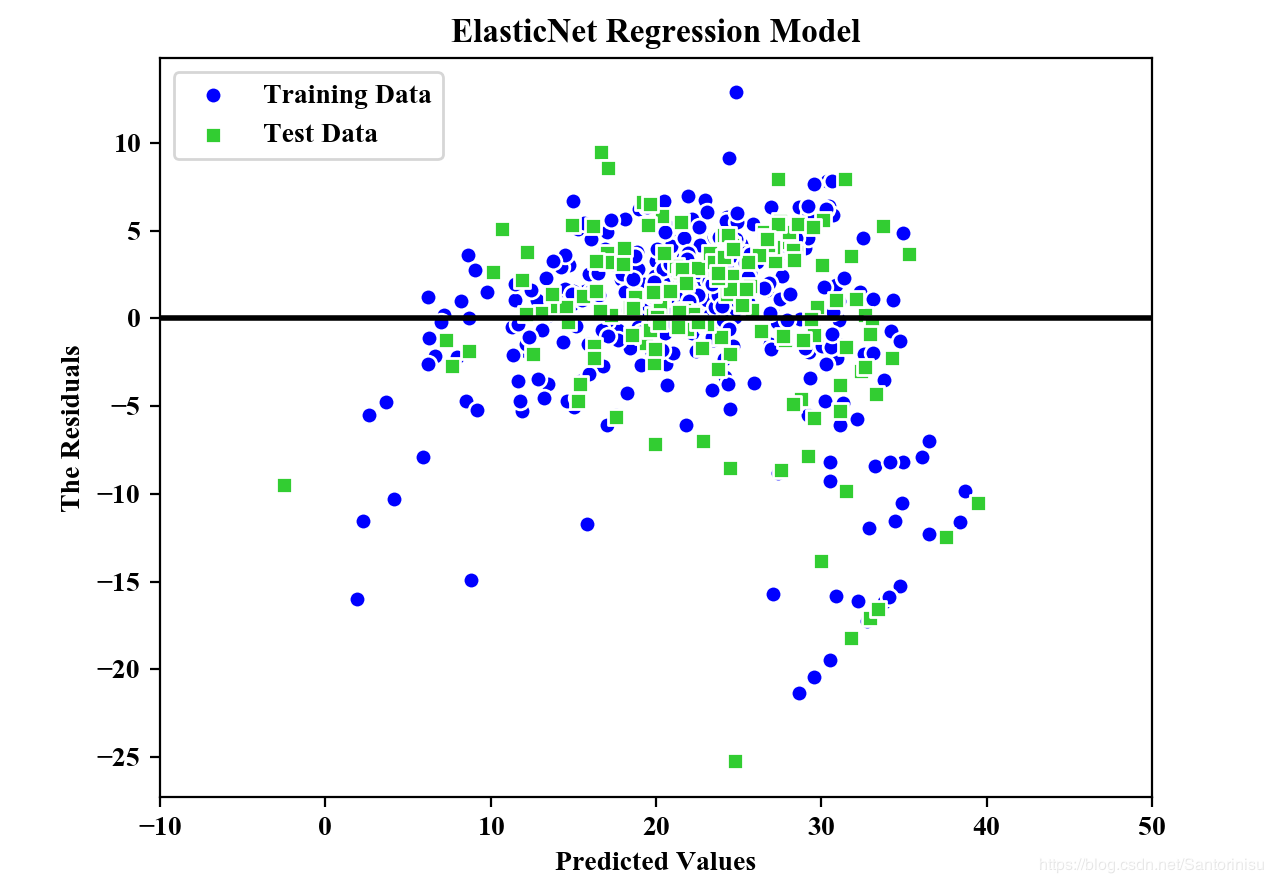机器学习-三种回归方法(Ridge、LASSO和ElasticNet回归)
Section I: Brief Introduction on Three Regression Models
作者:Santorinisu
Regulation is one approach to tackle the problem of overfitting by adding additional information, and thereby shrinking the parameter values of the model to induce a penalty against complexity. The most popular approaches to regularized linear regression are the so-called Ridge Regression, Least Absolute Shrinkage and Selection Operator(LASSO), AND Elastic Net Models.
Ridge Regression: L2 Regulation LASSO Regression: L1 Regulation ElasticNet Regression: L2 and L1 RegulationTwo Quantitative Measures
Mean Square Error(MSE) R2 Score - Standard Version of MSEFROM
Sebastian Raschka, Vahid Mirjalili. Python机器学习第二版. 南京:东南大学出版社,2018.
第一部分:Ridge Regression
代码
from sklearn import datasets
from sklearn.model_selection import train_test_split
from sklearn.linear_model import LinearRegression
from sklearn.metrics import mean_squared_error,r2_score
import matplotlib.pyplot as plt
import warnings
warnings.filterwarnings("ignore")
plt.rcParams['figure.dpi']=200
plt.rcParams['savefig.dpi']=200
font = {'family': 'Times New Roman',
'weight': 'light'}
plt.rc("font", **font)
#Section 1: Load data and split it into Train/Test dataset
price=datasets.load_boston()
X=price.data
y=price.target
X_train,X_test,y_train,y_test=train_test_split(X,y,
test_size=0.3)
#Section 2: Ridge Regression and Least Shrinkage and Selection Operator(LASSO) AND Elastic Net
#Ridge: L2 Regulation
#LASSO: L1 Regulation
#Elastic Net: Both L1 and L2 Regulation
#Section 2.1: Ridge Model
#The parameter alpha would be the regulation stength.
from sklearn.linear_model import Ridge
ridge=Ridge(alpha=1.0)
ridge.fit(X_train,y_train)
y_train_pred=ridge.predict(X_train)
y_test_pred=ridge.predict(X_test)
plt.scatter(y_train_pred,y_train_pred-y_train,
c='blue',marker='o',edgecolor='white',
label='Training Data')
plt.scatter(y_test_pred,y_test_pred-y_test,
c='limegreen',marker='s',edgecolors='white',
label='Test Data')
plt.xlabel("Predicted Values")
plt.ylabel("The Residuals")
plt.legend(loc='upper left')
plt.hlines(y=0,xmin=-10,xmax=50,color='black',lw=2)
plt.xlim([-10,50])
plt.title("Ridge Regression Model")
plt.savefig('./fig2.png')
plt.show()
print("\nMSE Train in Ridge: %.3f, Test: %.3f" % \
(mean_squared_error(y_train,y_train_pred),
mean_squared_error(y_test,y_test_pred)))
print("R^2 Train in Ridge: %.3f, Test: %.3f" % \
(r2_score(y_train,y_train_pred),
r2_score(y_test,y_test_pred)))
结果

预测精度:
MSE Train in Ridge: 20.889, Test: 25.470
R^2 Train in Ridge: 0.739, Test: 0.728
第二部分:LASSO Regression
在第一部分的基础上,进一步添加如下代码。
代码
#Section 2.2: LASSO Model
#The parameter alpha would be the regulation stength.
from sklearn.linear_model import Lasso
lasso=Lasso(alpha=1.0)
lasso.fit(X_train,y_train)
y_train_pred=lasso.predict(X_train)
y_test_pred=lasso.predict(X_test)
plt.scatter(y_train_pred,y_train_pred-y_train,
c='blue',marker='o',edgecolor='white',
label='Training Data')
plt.scatter(y_test_pred,y_test_pred-y_test,
c='limegreen',marker='s',edgecolors='white',
label='Test Data')
plt.xlabel("Predicted Values")
plt.ylabel("The Residuals")
plt.legend(loc='upper left')
plt.hlines(y=0,xmin=-10,xmax=50,color='black',lw=2)
plt.xlim([-10,50])
plt.title("LASSO Regression Model")
plt.savefig('./fig3.png')
plt.show()
print("\nMSE Train in LASSO: %.3f, Test: %.3f" % \
(mean_squared_error(y_train,y_train_pred),
mean_squared_error(y_test,y_test_pred)))
print("R^2 Train in LASSO: %.3f, Test: %.3f" % \
(r2_score(y_train,y_train_pred),
r2_score(y_test,y_test_pred)))
结果

预测精度:
MSE Train in LASSO: 25.618, Test: 32.727
R^2 Train in LASSO: 0.680, Test: 0.650
第三部分:ElasticNet Regression
在第一、二部分的基础上,进一步添加如下代码。
代码
#Section 2.3: Elastic Net Model
#The parameter alpha would be the regulation stength.
from sklearn.linear_model import ElasticNet
elastic_net=ElasticNet(alpha=1.0,l1_ratio=0.5)
elastic_net.fit(X_train,y_train)
y_train_pred=elastic_net.predict(X_train)
y_test_pred=elastic_net.predict(X_test)
plt.scatter(y_train_pred,y_train_pred-y_train,
c='blue',marker='o',edgecolor='white',
label='Training Data')
plt.scatter(y_test_pred,y_test_pred-y_test,
c='limegreen',marker='s',edgecolors='white',
label='Test Data')
plt.xlabel("Predicted Values")
plt.ylabel("The Residuals")
plt.legend(loc='upper left')
plt.hlines(y=0,xmin=-10,xmax=50,color='black',lw=2)
plt.xlim([-10,50])
plt.title("ElasticNet Regression Model")
plt.savefig('./fig4.png')
plt.show()
print("\nMSE Train in ElasticNet: %.3f, Test: %.3f" % \
(mean_squared_error(y_train,y_train_pred),
mean_squared_error(y_test,y_test_pred)))
print("R^2 Train in ElasticNet: %.3f, Test: %.3f" % \
(r2_score(y_train,y_train_pred),
r2_score(y_test,y_test_pred)))
结果

预测精度:
MSE Train in ElasticNet: 24.999, Test: 31.943
R^2 Train in ElasticNet: 0.688, Test: 0.659
参考文献
Sebastian Raschka, Vahid Mirjalili. Python机器学习第二版. 南京:东南大学出版社,2018.
附录
from sklearn import datasets
from sklearn.model_selection import train_test_split
from sklearn.linear_model import LinearRegression
from sklearn.metrics import mean_squared_error,r2_score
import matplotlib.pyplot as plt
import warnings
warnings.filterwarnings("ignore")
plt.rcParams['figure.dpi']=200
plt.rcParams['savefig.dpi']=200
font = {'family': 'Times New Roman',
'weight': 'light'}
plt.rc("font", **font)
#Section 1: Load data and split it into Train/Test dataset
price=datasets.load_boston()
X=price.data
y=price.target
X_train,X_test,y_train,y_test=train_test_split(X,y,
test_size=0.3)
#Section 2: Ridge Regression and Least Shrinkage and Selection Operator(LASSO) AND Elastic Net
#Ridge: L2 Regulation
#LASSO: L1 Regulation
#Elastic Net: Both L1 and L2 Regulation
#Section 2.1: Ridge Model
#The parameter alpha would be the regulation stength.
from sklearn.linear_model import Ridge
ridge=Ridge(alpha=1.0)
ridge.fit(X_train,y_train)
y_train_pred=ridge.predict(X_train)
y_test_pred=ridge.predict(X_test)
plt.scatter(y_train_pred,y_train_pred-y_train,
c='blue',marker='o',edgecolor='white',
label='Training Data')
plt.scatter(y_test_pred,y_test_pred-y_test,
c='limegreen',marker='s',edgecolors='white',
label='Test Data')
plt.xlabel("Predicted Values")
plt.ylabel("The Residuals")
plt.legend(loc='upper left')
plt.hlines(y=0,xmin=-10,xmax=50,color='black',lw=2)
plt.xlim([-10,50])
plt.title("Ridge Regression Model")
plt.savefig('./fig2.png')
plt.show()
print("\nMSE Train in Ridge: %.3f, Test: %.3f" % \
(mean_squared_error(y_train,y_train_pred),
mean_squared_error(y_test,y_test_pred)))
print("R^2 Train in Ridge: %.3f, Test: %.3f" % \
(r2_score(y_train,y_train_pred),
r2_score(y_test,y_test_pred)))
#Section 2.2: LASSO Model
#The parameter alpha would be the regulation stength.
from sklearn.linear_model import Lasso
lasso=Lasso(alpha=1.0)
lasso.fit(X_train,y_train)
y_train_pred=lasso.predict(X_train)
y_test_pred=lasso.predict(X_test)
plt.scatter(y_train_pred,y_train_pred-y_train,
c='blue',marker='o',edgecolor='white',
label='Training Data')
plt.scatter(y_test_pred,y_test_pred-y_test,
c='limegreen',marker='s',edgecolors='white',
label='Test Data')
plt.xlabel("Predicted Values")
plt.ylabel("The Residuals")
plt.legend(loc='upper left')
plt.hlines(y=0,xmin=-10,xmax=50,color='black',lw=2)
plt.xlim([-10,50])
plt.title("LASSO Regression Model")
plt.savefig('./fig3.png')
plt.show()
print("\nMSE Train in LASSO: %.3f, Test: %.3f" % \
(mean_squared_error(y_train,y_train_pred),
mean_squared_error(y_test,y_test_pred)))
print("R^2 Train in LASSO: %.3f, Test: %.3f" % \
(r2_score(y_train,y_train_pred),
r2_score(y_test,y_test_pred)))
#Section 2.3: Elastic Net Model
#The parameter alpha would be the regulation stength.
from sklearn.linear_model import ElasticNet
elastic_net=ElasticNet(alpha=1.0,l1_ratio=0.5)
elastic_net.fit(X_train,y_train)
y_train_pred=elastic_net.predict(X_train)
y_test_pred=elastic_net.predict(X_test)
plt.scatter(y_train_pred,y_train_pred-y_train,
c='blue',marker='o',edgecolor='white',
label='Training Data')
plt.scatter(y_test_pred,y_test_pred-y_test,
c='limegreen',marker='s',edgecolors='white',
label='Test Data')
plt.xlabel("Predicted Values")
plt.ylabel("The Residuals")
plt.legend(loc='upper left')
plt.hlines(y=0,xmin=-10,xmax=50,color='black',lw=2)
plt.xlim([-10,50])
plt.title("ElasticNet Regression Model")
plt.savefig('./fig4.png')
plt.show()
print("\nMSE Train in ElasticNet: %.3f, Test: %.3f" % \
(mean_squared_error(y_train,y_train_pred),
mean_squared_error(y_test,y_test_pred)))
print("R^2 Train in ElasticNet: %.3f, Test: %.3f" % \
(r2_score(y_train,y_train_pred),
r2_score(y_test,y_test_pred)))
作者:Santorinisu
相关文章
Quirita
2021-04-07
Iris
2021-08-03
Serwa
2020-03-20
Mangena
2020-03-02
Hester
2023-07-22
Grace
2023-07-22
Vanna
2023-07-22
Peony
2023-07-22
Dorothy
2023-07-22
Dulcea
2023-07-22
Zandra
2023-07-22
Serafina
2023-07-24
Kathy
2023-08-08
Olivia
2023-08-08
Elina
2023-08-08
Jacinthe
2023-08-08
Viridis
2023-08-08
Hana
2023-08-08
Cybill
2023-08-08